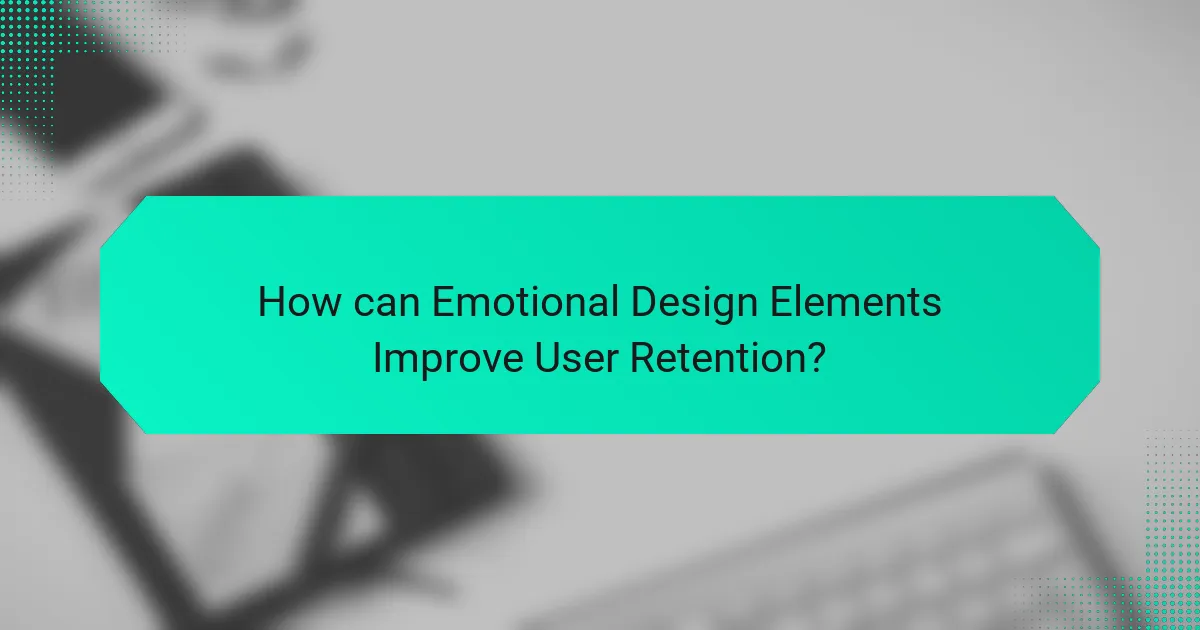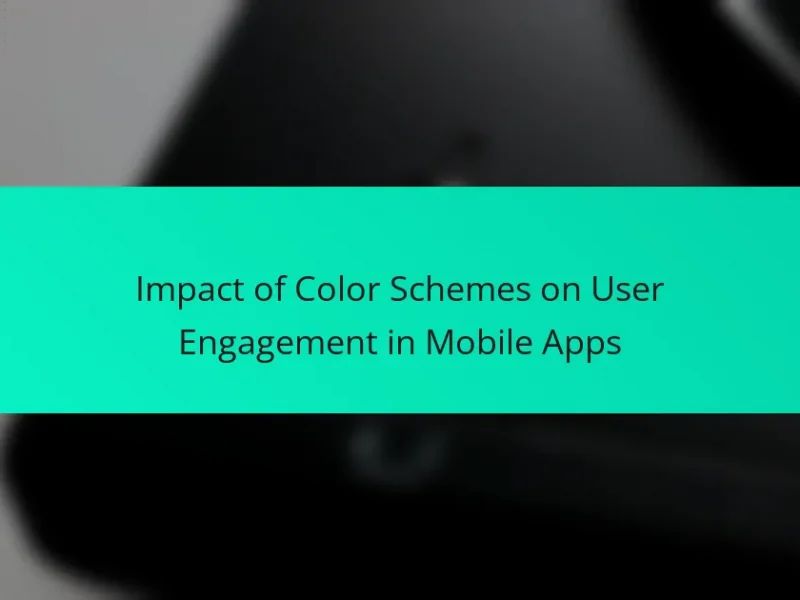Emotional design elements in mobile applications are features that evoke specific feelings in users, enhancing their overall experience and fostering emotional connections. Key components of emotional design include color schemes, typography, and visual imagery, which can elicit feelings such as comfort, nostalgia, and excitement. Research highlights that integrating these emotional design elements can lead to a significant increase in user retention rates, with studies showing up to a 20% improvement. Best practices for implementing emotional design involve understanding user emotions, creating engaging visuals, and offering personalized experiences, all of which contribute to building loyalty and long-term relationships between users and the app.

What are Emotional Design Elements in Mobile Apps?
Emotional design elements in mobile apps are features that evoke specific feelings in users. These elements enhance user experience by creating emotional connections. Common emotional design elements include color schemes, typography, and visual imagery. For instance, warm colors can create a sense of comfort. Typography can convey personality and tone. Visual imagery can evoke nostalgia or excitement. Research indicates that emotional engagement leads to higher user retention. A study by Norman Nielsen Group found that users are more likely to return to apps that resonate emotionally. Therefore, integrating emotional design elements is crucial for improving user retention in mobile applications.
How do Emotional Design Elements influence user behavior?
Emotional design elements significantly influence user behavior by shaping user experiences and interactions. These elements evoke feelings that can lead to increased engagement and satisfaction. For instance, visually appealing designs can create positive emotions, encouraging users to spend more time on an app. Research shows that users are more likely to return to apps that elicit strong emotional responses. A study by Desmet and Hekkert (2007) indicates that emotions play a crucial role in product design, impacting user loyalty. Additionally, emotional design can enhance usability by making interfaces more intuitive and enjoyable. This connection between emotions and user behavior is critical for improving user retention in mobile apps.
What psychological principles underpin Emotional Design Elements?
Emotional design elements are underpinned by psychological principles such as the principle of affect, cognitive appraisal theory, and the theory of affordances. The principle of affect suggests that emotions influence users’ perceptions and interactions with design elements. Cognitive appraisal theory explains how individuals evaluate emotional experiences, impacting their responses to design. The theory of affordances highlights how design elements suggest their use, guiding user behavior. Research shows that emotionally engaging designs can enhance user satisfaction and retention. For instance, a study by Desmet and Hekkert (2007) in “Designing Emotions” illustrates how emotional responses to design can affect user engagement.
How do users perceive Emotional Design Elements?
Users perceive Emotional Design Elements as crucial for enhancing their experience with mobile apps. These elements evoke feelings and create connections, influencing user satisfaction and loyalty. Research indicates that emotional design can lead to increased engagement. For example, a study by Desmet and Hekkert highlights that emotional responses significantly impact user behavior. Users often appreciate designs that resonate with their feelings and preferences. Positive emotional experiences can lead to higher retention rates in mobile applications. Thus, emotional design is a key factor in user perception and app success.
Why is User Retention Important for Mobile Apps?
User retention is crucial for mobile apps because it directly impacts revenue and growth. High retention rates indicate user satisfaction and loyalty. According to a study by Localytics, apps with high retention can see up to 200% more revenue than those with lower rates. Retained users are more likely to engage with in-app purchases and advertisements. Moreover, acquiring new users is typically five times more expensive than retaining existing ones. This makes user retention a cost-effective strategy for sustainable business growth. Additionally, consistent user engagement leads to valuable feedback for app improvement.
What metrics indicate user retention in mobile apps?
User retention in mobile apps is indicated by several key metrics. These include Daily Active Users (DAU), which measures the number of unique users who engage with the app daily. Monthly Active Users (MAU) tracks the unique users over a month, providing a broader view of engagement. Retention Rate measures the percentage of users who return to the app after their first use, often evaluated over specific time frames like day 1, day 7, and day 30. Churn Rate indicates the percentage of users who stop using the app over a given period. Session Length measures the average time users spend in the app during each visit. Lastly, User Lifetime Value (LTV) estimates the total revenue a user generates during their time with the app. These metrics collectively provide insights into user engagement and app loyalty, which are critical for assessing retention.
How does user retention impact app profitability?
User retention significantly impacts app profitability. Higher user retention leads to increased lifetime value (LTV) of each user. Retained users are more likely to make repeat purchases or engage with premium features. According to a study by Bain & Company, increasing customer retention rates by just 5% can increase profits by 25% to 95%. Additionally, retained users often become brand advocates, driving new user acquisition through referrals. This organic growth reduces marketing costs, further enhancing profitability. Therefore, effective emotional design elements that improve user retention can directly contribute to a more profitable app.

How can Emotional Design Elements Improve User Retention?
Emotional design elements can significantly improve user retention by creating a deeper connection between users and the app. These elements evoke feelings such as joy, trust, and satisfaction. When users experience positive emotions, they are more likely to return to the app. Research indicates that apps with engaging emotional design see up to a 20% increase in user retention rates. A study by Norman (2004) highlights that emotional engagement leads to loyalty and repeated use. Additionally, personalized experiences enhance user satisfaction, making users feel valued. This emotional connection fosters long-term relationships, ultimately boosting retention.
What specific Emotional Design Elements enhance user engagement?
Emotional design elements that enhance user engagement include color, typography, imagery, and interactivity. Color affects users’ moods and can create emotional responses. For example, warm colors often evoke excitement, while cool colors can induce calmness. Typography influences readability and conveys brand personality. Clear and appealing fonts can enhance user experience. Imagery, such as relatable visuals, fosters connection and empathy. Interactivity, like animations and feedback, engages users and encourages exploration. Research by Norman (2004) in “Emotional Design: Why We Love (or Hate) Everyday Things” shows that these elements significantly impact user satisfaction and retention.
How does visual design contribute to emotional engagement?
Visual design significantly contributes to emotional engagement by creating a connection between users and content. Elements such as color, typography, and imagery evoke specific feelings. For instance, warm colors like red and orange can stimulate excitement, while cool colors like blue promote calmness. Typography influences readability and tone, affecting user perception. High-quality images can create a sense of authenticity and trust. Research shows that visually appealing designs increase user satisfaction by 60%. This correlation between visual aesthetics and emotional response enhances user retention in mobile apps.
What role does storytelling play in user retention?
Storytelling enhances user retention by creating emotional connections with users. It engages users through relatable narratives and characters. This emotional engagement fosters loyalty and encourages users to return. Research shows that stories can increase information retention by up to 65%. Users are more likely to remember and engage with brands that tell compelling stories. Storytelling also differentiates apps in a crowded market. This differentiation can lead to higher user satisfaction and retention rates.
How can feedback and interaction design foster emotional connections?
Feedback and interaction design can foster emotional connections by creating responsive and engaging user experiences. Effective feedback provides users with immediate responses to their actions. This responsiveness makes users feel acknowledged and valued. Interaction design that prioritizes user emotions enhances satisfaction and loyalty. For example, visual and auditory feedback can evoke positive feelings during interactions. Research shows that users who receive timely feedback are more likely to develop a sense of attachment to the application. Additionally, personalized interactions can deepen emotional connections by addressing individual user preferences. Therefore, thoughtful feedback and interaction design are essential for cultivating emotional bonds with users.
What types of feedback are most effective in mobile apps?
Effective feedback types in mobile apps include visual, auditory, and haptic feedback. Visual feedback provides immediate responses through animations or color changes. Auditory feedback uses sounds to confirm actions or alerts. Haptic feedback delivers tactile sensations, enhancing user interaction. Research indicates that these feedback types improve user satisfaction and retention rates. For instance, a study by Nielsen Norman Group shows that well-designed feedback can lead to a 20% increase in user engagement.
How does personalization affect user emotional responses?
Personalization significantly enhances user emotional responses by creating a sense of relevance and connection. Tailored experiences resonate more deeply with users. This connection can lead to increased satisfaction and loyalty. Research indicates that 80% of consumers are more likely to make a purchase when brands offer personalized experiences. Personalized content can trigger positive emotions such as happiness and trust. Users feel valued when their preferences are recognized. This emotional engagement can reduce churn rates in mobile apps. Ultimately, personalization fosters a more meaningful user experience that encourages long-term retention.

What are Best Practices for Implementing Emotional Design in Mobile Apps?
Best practices for implementing emotional design in mobile apps include understanding user emotions, creating engaging visuals, and using personalized experiences. First, identify the target audience’s emotional triggers. Conduct user research to gather insights on their feelings and preferences. Next, design intuitive interfaces that evoke positive emotions. Use colors, typography, and imagery that resonate with users. Incorporate storytelling elements to create a narrative that users can connect with emotionally. Additionally, leverage feedback mechanisms to allow users to express their feelings about the app. This interaction fosters a sense of community and belonging. Lastly, ensure consistent updates and improvements to demonstrate care for user experiences. Regular enhancements can lead to increased user loyalty and retention.
How can developers create a cohesive emotional experience?
Developers can create a cohesive emotional experience by integrating consistent design elements throughout the app. This includes visual aesthetics, color schemes, and typography that evoke specific emotions. Consistency in user interface design fosters familiarity and comfort. Developers should also implement storytelling techniques to engage users emotionally. Incorporating user feedback can refine emotional responses. Research shows that emotional engagement increases user retention rates. A study by the Nielsen Norman Group found that users are more likely to return to apps that elicit positive emotions. By focusing on these strategies, developers can enhance the overall emotional experience for users.
What tools and methodologies support emotional design integration?
Emotional design integration is supported by various tools and methodologies. User-centered design (UCD) focuses on understanding user needs and emotions. This approach involves user research methods like interviews and surveys. Emotional journey mapping visualizes user emotions throughout their interaction. Prototyping tools like Figma and Sketch enable iterative design testing. Design thinking fosters creativity in solving user problems. Usability testing assesses emotional responses to designs. A/B testing compares different design variations to gauge user sentiment. These methodologies ensure that emotional aspects are effectively integrated into the design process.
How can user testing inform emotional design decisions?
User testing can inform emotional design decisions by providing direct insights into user feelings and reactions. It allows designers to observe how users interact with a product. This observation can reveal emotional responses that may not be articulated. For instance, users may express frustration through body language or vocal cues. These reactions can guide designers in refining elements that evoke positive emotions. Research indicates that products designed with emotional considerations improve user satisfaction. A study by Desmet and Hekkert (2007) highlights that understanding user emotions enhances design outcomes. Therefore, user testing serves as a critical tool for aligning design with emotional user experiences.
What common challenges do developers face in emotional design?
Developers face several common challenges in emotional design. One significant challenge is understanding user emotions accurately. Emotional design requires a deep understanding of user psychology. Misinterpreting user emotions can lead to ineffective design solutions. Another challenge is balancing aesthetics with functionality. Developers often struggle to create visually appealing designs that also serve practical purposes. Additionally, developers may find it difficult to measure emotional responses. Quantifying emotions can be subjective and complex. Integrating emotional design into existing workflows poses another challenge. Developers may lack the necessary tools or frameworks for effective implementation. Lastly, maintaining consistency in emotional design across different platforms can be challenging. Inconsistent experiences can confuse users and diminish emotional engagement.
How can developers overcome resistance to emotional design elements?
Developers can overcome resistance to emotional design elements by demonstrating their impact on user engagement. Emotional design enhances user experience and fosters deeper connections. Research by Norman (2004) indicates that emotional elements lead to higher user satisfaction. Developers can use data analytics to show metrics like increased retention rates. They can also conduct user testing to gather feedback on emotional design features. Presenting case studies of successful apps can further illustrate effectiveness. Engaging stakeholders in workshops can help address concerns and build consensus. By providing evidence and involving the team, developers can facilitate acceptance of emotional design elements.
What are the risks of neglecting emotional design in mobile apps?
Neglecting emotional design in mobile apps can lead to poor user engagement and high churn rates. Users may feel disconnected or frustrated with the app experience. This emotional disconnect can result in negative reviews and decreased user loyalty. Research shows that emotionally engaging designs can enhance user satisfaction and retention. For instance, a study by Norman Nielsen Group found that users are more likely to return to apps that evoke positive emotions. Without emotional design, apps may fail to create meaningful connections with users, ultimately impacting their success in a competitive market.
What practical tips can enhance emotional design for better user retention?
To enhance emotional design for better user retention, focus on creating a user-centric experience. Utilize storytelling to connect users emotionally with the app. Incorporate visual elements that evoke positive feelings, such as warm colors and friendly icons. Ensure intuitive navigation to reduce frustration and enhance satisfaction. Provide personalized content based on user preferences and behaviors. Use feedback mechanisms to show users their input is valued. Implement gamification elements to make interactions enjoyable and rewarding. Regularly update the app to maintain user interest and engagement. These strategies are supported by studies showing that emotional connections increase user loyalty and retention rates.
The main entity of this article is “Emotional Design Elements” in the context of mobile apps. The article examines how these design elements, including color schemes, typography, and visual imagery, evoke specific emotions and enhance user experience, ultimately leading to improved user retention. It discusses the psychological principles that underpin emotional design, the metrics that indicate user retention, and the impact of emotional engagement on app profitability. Additionally, it outlines best practices for implementing emotional design, the challenges developers face, and practical tips to foster emotional connections, all aimed at increasing user satisfaction and loyalty in mobile applications.


